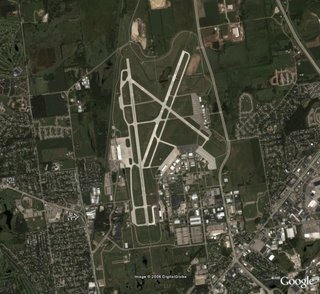Lesson 42 – Class Charlie
 Today’s lesson was a dual cross country to Madison, Wisconsin for familiarization with Class C airspace. This is different from the Class D at Waukegan in that you talk to approach control on arrival and departure control on takeoff. These are radar facilities that provide an orderly flow of aircraft into and out of the airport area. It’s not necessarily any harder than flying into Class D, it’s just different and something I needed to learn.
Today’s lesson was a dual cross country to Madison, Wisconsin for familiarization with Class C airspace. This is different from the Class D at Waukegan in that you talk to approach control on arrival and departure control on takeoff. These are radar facilities that provide an orderly flow of aircraft into and out of the airport area. It’s not necessarily any harder than flying into Class D, it’s just different and something I needed to learn.
When I got to the airport at 8:30 AM, I already had most of the flight planning done. Sandy checked over some of my numbers then went to dispatch the airplane while I finished up. She was back in just a couple minutes to tell me to take my time. We thought there was no one ahead of us the schedule but, a last minute change sent our plane out on another flight. We would have to wait until it got back at 10:00. We spent the time double checking my planning and discussing what to expect along the route and in the Class C.
Once we did get airborne, the lesson went very well. I used a combination of pilotage, dead reckoning and VOR navigation to get practice in all of them. I also did all the radio work including calling Flight Service to open our flight plans both ways and talking to approach, tower and ground on the way in and ground, tower and departure when leaving Madison. I was busy for the whole flight.
I was able to, pretty much, stay on my planned course flying to Madison. Coming back was a different story. A direct route home would have taken us south east but, departure control kept us heading due east for a long time. When they finally released us, we were far north of our planned course. This was a good lesson in making up a new plan on the fly when things don’t go as expected. Sandy made sure I kept looking at the sectional chart and keeping track of just where we were and where we had to go. Positional awareness is very important in cross country flying and this was a very good lesson in that.
One problem that I still have is holding exact headings and altitudes while doing other things like reading charts and tuning the radios. I’m getting better at it but I’m still not happy with my performance. I tend to turn right when I look down. I feel it happening right away though so I didn’t turn very far. The bigger problem is gaining or losing altitude when my attention is inside the airplane. I’m not varying by the 500 feet I did earlier in my training but, I still find myself off by 150 to 200 feet at times. The Practical Test Standards call for holding altitude within 100 feet, so I have some work to do to get better.
Session expired
Please log in again. The login page will open in a new tab. After logging in you can close it and return to this page.

You are making GREAT progress! I have had the same problems with airwork when distracted by other things in the cockpit (especially with a GPS). Let go. What i do is ‘guard’ the control with my left hand, but let go of the yoke. If it is trimmed right, it should be flying straight and level while you check on other things.
Thanks for the reminder Dave. I do have to remember to let the airplane fly itself at times.
Tom